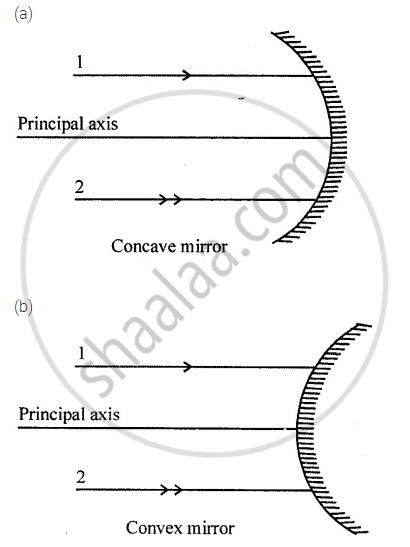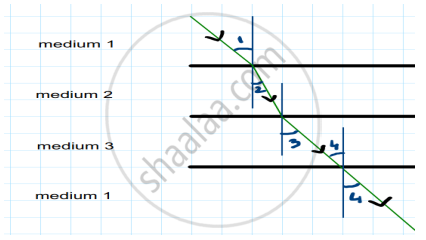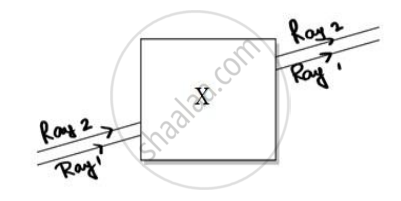Advertisements
Advertisements
प्रश्न
Fill in the blank and Explain the completed sentences.
The change in ______ of light rays while going from one medium to another is called refraction.
उत्तर
The change in direction of light rays while going from one medium to another is called refraction.
Explanation:
- Light changes its direction when going from one transparent medium to another transparent medium. This is called the refraction of light.
- As every medium has a different refractive index, this causes the direction of light to change.
APPEARS IN
संबंधित प्रश्न
What is refraction of light?
Name the phenomenon responsible for the following effect:
When we sit in front of a plane mirror and write with our right hand, if appears in the mirror that we are writing with the left hand.
What is lateral inversion? Explain by giving a suitable example.
What are the important differences between looking at a photograph of your face and looking at yourself in a plane mirror?
What is the difference between regular reflection of light and diffuse reflection of light?
What type of reflection of light takes place from a cinema screen?
The boy walks towards the mirror at a speed of 1 m/s. At what speed does his image approach him?
Define the following terms used in the study of reflection of light by drawing a labelled ray-diagram:
(a) Incident ray
(b) Point of incidence
(c) Normal
(d) Reflected ray
(e) Angle of incidence
(f) Angle of reflection
Write all the capital letters of the alphabet which look the same in a plane mirror.
The image formed by a plane mirror is :
(a) virtual, behind the mirror and enlarged.
(b) virtual, behind the mirror and of the same size as the object.
(c) real, at the surface of the mirror and enlarged.
(d) real, behind the mirror and of the same size as the object.
A man stands 10 m in front of a large plane mirror. How far must the walk before he is 5 m away from his image?
A ray of light strikes a plane mirror PQ at an angle of incidence of 30°, is reflected from the plane mirror and then strikes a second plane mirror QR placed at right angles to the first mirror. The angle of reflection at the second mirror is ______.
State two effects caused by the refraction of light.
As light rays pass from water into glass, are they refracted towards the normal or away from the normal?
A coin in a glass tumbler appears to rise as the glass tumbler is slowly filled with water. Name the phenomenon responsible for this effect.
With the help of a labelled diagram, explain why a tank full of water appears less deep than it actually is.
Name the phenomenon due to which a pencil partly immersed in water and held obliquely appears to be bent at the water surface.
With the help of a diagram, show how when light falls obliquely on the side of a rectangular glass slab, the emergent ray is parallel to the incident ray.
A ray of light passes from a medium X to another medium Y. No refraction of light occurs if the ray of light hits the boundary of medium Y at an angle of:
(a) 0°
(b) 45°
(c) 90°
(d) 120°
Water is optically .......... than air.
When a ray of light travels from air to glass, it bends .......... the normal.
The diagram (figure) given below shows two parallel rays 1 and 2 incident on (a) a concave mirror, (b) a convex mirror. Draw the reflected rays and mark the focus by the symbol F.

We can see the sun even when it is little below the horizon because of ______.
Define the principal focus of a concave mirror.
What is atmospheric reflection? Explain with the help of a labelled diagram that the position of a star as seen by us is not its true position.
The phenomenon of change in the direction of light when it passes from one transparent medium to another is called ___________.
Due to _______ pencil looks bent in water, in the given experiment.

The speed of light varies in different media.
Write scientific reason.
The bottom of a pond appears raised.
State whether true or false. If false, correct the statement.
The angle of deviation depends on the refractive index of the glass.
The refractive index of a transparent medium is always greater than ______.
You are given water, mustard oil, glycerine and kerosene. In which of these media a ray of light incident obliquely at same angle would bend the most?

In the above diagram light is travelling through different media. It is noted by a scientist that ∠1= ∠3 = ∠4 but ∠2 < ∠1. Which of the following statement would be correct?
Noor, a young student, was trying to demonstrate some properties of light in her Science project work. She kept ‘X’ inside the box (as shown in the figure) and with the help of a laser pointer made light rays pass through the holes on one side of the box. She had a small butter-paper screen to see the spots of light being cast as they emerged.

Her friend noted the following observations from this demonstration:
- Glass is optically rarer than air.
- Air and glass allow light to pass through them with the same velocity.
- Air is optically rarer than glass.
- Speed of light through a denser medium is faster than that of a rarer medium.
- The ratio: sin of angle of incidence in the first medium to the ratio of sin of angle of refraction in the second medium, gives the refractive index of the second material with respect to the first one.
Which one of the combinations of the above statements given below is correct.
A pencil when dipped in water in a glass tumbler appears to be bent at the interface of air and water. Will the pencil appear to be bent to the same extent, if instead of water we use liquids like, kerosene or turpentine. Support your answer with reason.
When light passes from one medium to another the ray gets bent. This property of light is called ______.
A water tank appears shallower when it is viewed from the top due to refraction.
